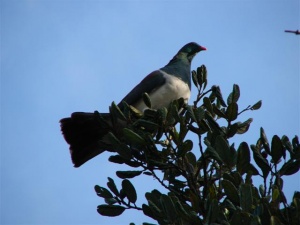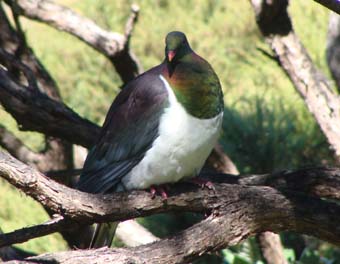Please show your support of Waihekepedia by adding a link to us from your web site. Waihekepedia T Shirts now available at the Ostend Market
Difference between revisions of "Kereru"
Jump to navigation
Jump to search
Hackademic (talk | contribs) |
|||
| (9 intermediate revisions by 3 users not shown) | |||
| Line 1: | Line 1: | ||
| − | [[Image:Kereru.JPG|left]] Kereru (Hemiphaga novaeseelandiae) | + | [[Image:Kereru.JPG|left|thumb|300px]] |
| + | |||
| + | == Kereru (Hemiphaga novaeseelandiae) == | ||
| + | |||
| + | In Māori it is the kererū, kūkū, or kukupa | ||
Once abundant numbers have declined dramatically due to habitat loss and predators. | Once abundant numbers have declined dramatically due to habitat loss and predators. | ||
| Line 5: | Line 9: | ||
Good populations still exist in Waiheke. | Good populations still exist in Waiheke. | ||
| − | Kereru are the only seed disperser of large fruits of trees such as the | + | Kereru are the only seed disperser of large fruits of trees such as the karaka and taraire. The Department of Conservation suggests the disappearance of the kereru would be a disaster for native forest generation. |
| + | |||
| + | Once an important food resource for Maori, the kereru, like all native birds, is these days protected and shows little fear of humans. | ||
| + | |||
| + | [[Image:kereru1.jpg|right|frame]] | ||
| + | |||
| + | [[Category:The environment]] | ||
| + | [[Category:Wildlife]] | ||
Latest revision as of 08:38, 2 June 2010
Kereru (Hemiphaga novaeseelandiae)
In Māori it is the kererū, kūkū, or kukupa
Once abundant numbers have declined dramatically due to habitat loss and predators.
Good populations still exist in Waiheke.
Kereru are the only seed disperser of large fruits of trees such as the karaka and taraire. The Department of Conservation suggests the disappearance of the kereru would be a disaster for native forest generation.
Once an important food resource for Maori, the kereru, like all native birds, is these days protected and shows little fear of humans.

